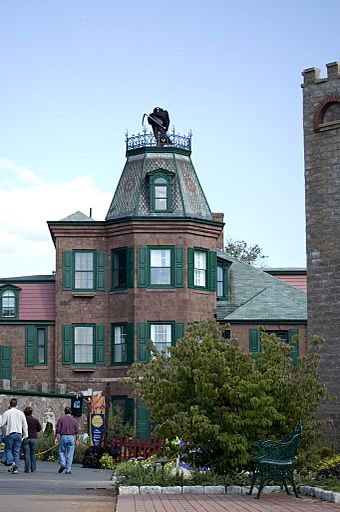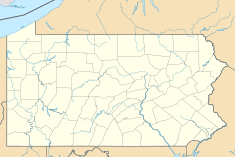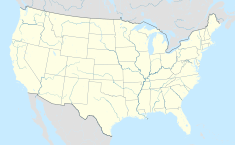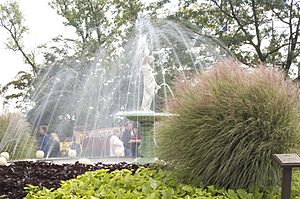Mount Hope Estate facts for kids
Quick facts for kids |
|
|
Mount Hope Estate
|
|

Mount Hope Estate is a Federal-style house with significant Victorian additions.
|
|
| Location | Rapho Township, Lancaster County, Pennsylvania |
|---|---|
| Area | 35 acres (14 ha) |
| Built | 1805, 1895 |
| Architectural style | Federal, Late Victorian |
| Visitation | 250,000 (Pennsylvania Renaissance Faire only) (2007) |
| MPS | Iron and Steel Resources of Pennsylvania |
| NRHP reference No. | 80003530, 91001146 |
| Added to NRHP | December 1, 1980, boundary increase in 1991 |
Mount Hope Estate is a special place in Lancaster County, Pennsylvania. It is listed on the National Register of Historic Places, which means it's an important historical site. This estate was once the main place for the Grubb Family Iron Dynasty in the 1800s. The Grubbs were a powerful family who made iron.
The estate used to be huge, covering over 2,500 acres. It had an iron furnace, a mill, homes for workers, a post office, a store, a train station, a school, and a church. Today, the beautiful mansion and its grounds are what remain of this busy industrial center and small village.
The mansion itself was first built in the Federal style around 1805. This style was popular in the early 1800s. Later, in 1895, it was updated with many Victorian features. The mansion and its other buildings are made from red sandstone found nearby. The estate also has a very old formal garden, which is rare to find from before 1840.
Today, Mount Hope Estate is home to the Mount Hope Estate and Winery, the Swashbuckler Brewing Company, and the famous Pennsylvania Renaissance Faire. Many other fun events happen here throughout the year.
Contents
History of Mount Hope Estate
Mount Hope Estate was the home and business center for the Grubb family, who were famous for making iron in the 1800s. The Grubb family came from England. Peter Grubb, a younger son of the family founder, came to this area around 1734. He found a lot of iron in Lebanon County and bought 300 acres of land.
By 1742, Peter Grubb started the very successful Cornwall Ironworks. This company was named after his father's home in England. By 1783, the family owned 10,000 acres! The land was later divided among family members.
In 1784, Peter Grubb's youngest son, Peter Grubb, Jr., bought more land and built an iron furnace. He called this place "Mount Hope." His two sons later inherited 2,307 acres, which became known as the "Mount Hope Estate." His youngest son, Henry Bates Grubb, bought his brother's share and built the mansion by 1805.
The Grubb Family's Influence
The Grubb family became very important in the area by 1784. From 1840 to 1870, they were the top iron makers in Pennsylvania. Mount Hope Estate was the heart of their business. Many important Pennsylvanians visited the estate during this time. These guests included bishops and other leading iron makers like Robert Coleman.
At its busiest, the estate had an iron furnace, homes for workers, and the Mount Hope Episcopal Church. This church, also called Hope Church, was mainly built for the Grubb family. The estate also had the mansion, many stone outbuildings, and large formal gardens.
After Henry Bates Grubb passed away, his wife, Harriet Amelia Buckley Grubb, managed the estate. In 1848–49, she had Hope Church built for the people living and working on the estate. In 1885, Clement Brooke Grubb, one of Henry's sons, bought the mansion and land for $300,000. He later gave the church and its yard to the Episcopal Diocese of Central Pennsylvania.
New Owners and Uses
When Clement died, his daughter, Daisy Elizabeth Brooke Grubb, inherited the estate. She was the last Grubb family member to own it. Daisy updated the 32-room mansion in the Victorian style. After Daisy's death, the property was divided and sold to different owners.
In 1980, Charles Romito bought the mansion and the land around it for $1 million. He wanted to open a winery there.
Mount Hope Estate and Winery Begins
After planting vineyards and making wines, Charles Romito opened the Mount Hope Estate and Winery in 1980. To help his new business, Romito hosted several events in the first year. These included an art show, a bluegrass concert, and a modern jousting tournament.
The jousting tournament was so popular that Romito held a two-day renaissance festival the next year. It started in the winery's parking lot and slowly grew into the big Pennsylvania Renaissance Faire we know today. The property was added to the National Register of Historic Places in 1980. Its boundaries were made larger in 1991 as part of a special study on iron and steel sites in Pennsylvania.
Architecture of the Mansion
The Mount Hope Estate mansion shows two main building styles. It was first built in the Federal style for Henry Bates Grubb between 1800 and 1805. It was the most formal mansion built for an iron master in the area during that time.
In 1895, Daisy Grubb made big changes to the mansion. She added a Victorian ballroom, a billiard room, fancy lights called chandeliers, and patterned wooden floors. She also changed some hinged doors to sliding doors. Even with these updates, much of the original building remained, including the front of the house and the fireplace mantels.
Outside the Mansion
The front of the house, facing south, has two stories and is made of local red sandstone. It looks much like it did when it was built between 1800 and 1805. The wooden porch along the front was likely rebuilt in 1895, looking similar to the original one.
The entire west side of the house changed a lot in 1895. A striking three-story bay window was added, which goes up to an eight-sided tower with a patterned roof. Another two-story bay window was built near the southwest corner. The biggest additions from 1895 are at the back (north) of the house. These include a conservatory with a glass dome and a greenhouse. The kitchen was also made larger. The east side of the house was also updated in 1895, using the same local red sandstone to match the front. Most of what you see on this side was built in 1895, except for some original gothic arches.
Inside the Mansion
The inside of the mansion is a mix of its original 1800–05 design and the Victorian changes from 1895.
The entry hall is mostly original. Most of the wood and decorations in this area are from 1800–05. Only a few parts of the spiral staircase were replaced in the Victorian style. The main change to the entry hall was adding false walls to turn the original hinged doors into sliding doors. The central hall on the second floor and the Washington Room were also changed very little.
The dining room, however, was greatly updated in 1895. Its size was increased with a bay window, and a parquet floor was put in. The room was decorated with cherry wood, a gold and crystal chandelier, and wall lights called sconces. The only original part left in the room was the fireplace mantel. The Pink Room, the library, and Daisy Grubb's bedroom were also extensively remodeled.
Several new rooms were added in 1895. A billiard room and a ballroom were built at the back of the house. Fancy bathrooms were also added on the second and third floors.
Grounds and Gardens
At one time, there were almost 30 other buildings on the estate, plus a wall around it. All were made from the same red sandstone found on the property. Some buildings, like Hope Church, are now on land that was sold or given away. Today, only four outbuildings remain on the estate, located behind and to the northeast of the mansion.
- The smokehouse is a two-story building with a sloped roof. It is thought to be from the early 1800s.
- East of the smokehouse is a small building that was used as a post office in the late 1800s. It might have been a schoolhouse first.
- The manager's farmhouse is two and a half stories tall and has an L-shape with a porch.
- The springhouse is also two and a half stories high.
Beautiful Gardens
The overall design of the gardens is based on English formal gardens. This design dates back to the original construction between 1800 and 1805. Even though some flower beds, decorative urns, and the round fountain were added in 1895, the main garden plan stayed the same. This makes it a very rare and well-preserved example of an American formal garden from before 1840.
Mount Hope Estate Brands
Swashbuckler Brewing Company
The Swashbuckler Brewing Company started making beer in 2000. It was founded by Scott Bowser, who also helps manage Mount Hope Estate & Winery. The brewery began on the grounds of the Pennsylvania Renaissance Faire. In 2015, beer making moved to a new building called SBC Brewsmiths, just outside the Fairegrounds. Swashbuckler Brewing Company continues to make beers for the many events at Mount Hope Estate.
Mount Hope Winery
Mount Hope Winery opened in 1980 to bring visitors to the estate. The vineyards and wine production were first located in Lake Erie County. In 2015, Mount Hope Winery brought its wine production back to Lancaster County. This happened when they bought the equipment from another winery that closed.
In late 2016, Mount Hope started turning an old barn into new winery facilities. This barn was built in the 1800s and rebuilt in 1908 after a fire. The new winery has a large space for new equipment, increasing its total wine-making capacity to 40,000 gallons. Large tanks outside hold juice for wine and cider. There is also a big cold storage unit for chilling the winery products.
Lancaster County Cider
In early 2016, Mount Hope added Lancaster County Cider to its drinks. This hard cider is very popular with visitors to the estate's events. You can find Lancaster County Cider at the Mount Hope Wine Shop in Manheim, the Mount Hope Wine Gallery in Bird-in-Hand, and the Mount Hope Wine Shop at Miller's Smorgasbord in Ronks. It is also sold through a distributor in Lancaster, PA. Lancaster County Cider has even partnered with the Reading Fightin Phils baseball team.
Pennsylvania Renaissance Faire
In 1980, a jousting tournament was held in the parking lot of the new winery. The next year, a two-day Renaissance fair took place. This event slowly grew into the huge Pennsylvania Renaissance Faire. Today, it runs for 12 weekends and attracts over 250,000 visitors every year.
The Faire features a recreated 16th-century Tudor village and a copy of the Globe Theatre. You can watch Shakespearean plays, listen to music, and see artisans making old-fashioned items like pottery. In 1998, the American Bus Association named the Faire one of the top 100 events in America for bus tours.
Other Fun Events
Besides the Renaissance Faire, the estate hosts many other public events. You can take tours of the mansion and taste wines throughout the year.
Every June, the site holds the Celtic Fling and Highland Games. The Fling features traditional and modern Celtic music, food, crafts, and competitions. A feis, which is an Irish dance competition, is also held. The Highland Games are official sports events, including classic challenges like caber tossing (throwing a large log) and hammer throwing.
In late fall and early winter, the mansion hosts theatrical performances. From late October to mid-November, "Poe Evermore" is performed. This is a storytelling event based on the spooky works of Edgar Allan Poe. Between Thanksgiving and Christmas, "Victorian Christmas" or "A Dickens of a Christmas" is performed, telling the classic story of A Christmas Carol.





